
Earl of Chesterfield, in the County of Derby, was a title in the Peerage of England. It was created in 1628 for Philip Stanhope, 1st Baron Stanhope. He had already been created Baron Stanhope, of Shelford in the County of Nottingham, in 1616, also in the Peerage of England. Stanhope's youngest son the Hon. Alexander Stanhope was the father of James Stanhope, 1st Earl Stanhope while his half-brother Sir John Stanhope of Elvaston was the great-grandfather of William Stanhope, 1st Earl of Harrington.

Viscount Cobham is a title in the Peerage of Great Britain that was created in 1718. Owing to its special remainder, the title has passed through several families. Since 1889, it has been held by members of the Lyttelton family.

Earl of Gosford is a title in the Peerage of Ireland. It was created in 1806 for Arthur Acheson, 2nd Viscount Gosford.

Earl of Limerick is a title that has been created twice in the Peerage of Ireland, associated first with the Dongan family, then with the Pery family.

Viscount Hill, of Hawkstone and of Hardwicke in the County of Salop, is a title in the Peerage of the United Kingdom. It was created in 1842 for General Rowland Hill. He had already been created Baron Hill, of Almaraz and of Hawkstone in the County of Salop, in 1814, with remainder to the heirs male of his body, and Baron Hill, of Almarez and of Hawkestone and Hardwicke in the County of Salop, in 1816, with remainder to the heirs male of his elder brother John Hill. The viscountcy was created with the same special remainder. On the first Viscount's death in 1842, the barony of 1814 became extinct as he had no male issue, while he was succeeded in the barony of 1816 and the Viscountcy according to the special remainders by his nephew Sir Rowland Hill, 4th Baronet. His son, the 3rd Viscount, sat as a Conservative Member of Parliament for Shropshire North. In 1875, he assumed by Royal licence the additional surname of Clegg, which was that of his maternal grandfather. He inherited financial problems from his father which led to the breakup and sale of the family estates.
Baron Huntingfield is a title that has been created three times, twice in the Peerage of England and once in the Peerage of Ireland. The first two creations were by writ, but little more is known about them, except that John de Huntingfield, who was created Baron Huntingfield in 1362, married Margery de Welles, daughter of John de Welles, 4th Baron Welles. John was dead by December 1376, when Margery remarried. Both titles probably became extinct or fell into abeyance on the death of their first holders. The third creation, Baron Huntingfield, of Heveningham Hall in the County of Suffolk, was created in the Peerage of Ireland in 1796 for Sir Joshua Vanneck, 3rd Baronet, Member of Parliament for Dunwich. His son, the second Baron, also represented this constituency in the House of Commons. His great-grandson, the fifth Baron, was Conservative Member of Parliament for Eye and Governor of Victoria. As of 2013 the titles are held by the latter's grandson, the seventh Baron, who succeeded his father in 1994.
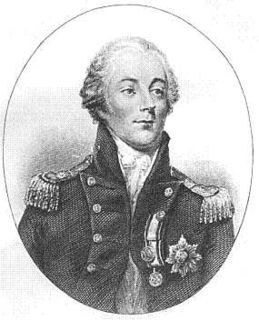
Baron de Saumarez, on the Island of Guernsey, is a title in the Peerage of the United Kingdom. It was created on 15 September 1831 for the prominent naval commander Admiral Sir James Saumarez, 1st Baronet. He had already been created a Baronet, of Guernsey, on 13 June 1801. Lord de Saumarez was succeeded by his eldest son James, the second Baron, a clergyman. James was succeeded by his younger brother, John, the third Baron, whose son, the fourth Baron, was a career diplomat who bought the family estate at Castel, Guernsey, from his father, the third Baron, who wished to sell it. However, by marrying an heiress, the fourth Baron also brought estates in Suffolk into the family.

Baron Avebury, of Avebury in the County of Wiltshire, is a title in the Peerage of the United Kingdom. It was created 22 January 1900 for the banker, politician and archaeologist Sir John Lubbock, 4th Baronet. He was succeeded by his eldest son, the second Baron. On his death the titles passed to his nephew, the third Baron. He was the son of Hon. Harold Fox Pitt Lubbock, fourth son of the first Baron, who died in 1971. The title then passed to the third Baron's first cousin, the fourth Baron, the son of Hon. Maurice Fox Pitt Lubbock, sixth son of the first Baron. The fourth baron was a Liberal Democrat politician and one of the ninety excepted hereditary peers who remained in the House of Lords after the passing of the House of Lords Act 1999. He was succeeded by his son, the fifth Baron, in 2016.

Baron Leigh has been created twice as a hereditary title, once in the Peerage of England and once in the Peerage of the United Kingdom. The first creation came in the Peerage of England 1643 when Sir Thomas Leigh, 2nd Baronet, was created Baron Leigh, of Stoneleigh in the County of Warwick. The Leigh Baronetcy, of Stoneleigh in the County of Warwick, had been created in 1611 for his grandfather and namesake Thomas Leigh. The latter was the second son of Sir Thomas Leigh, Lord Mayor of London in 1558, whose third son Sir William Leigh was the grandfather of Francis Leigh, 1st Earl of Chichester. The titles became extinct on the death of the fifth Baron Leigh in 1786.
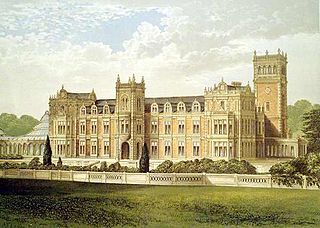
Baron Somerleyton, of Somerleyton in the County of Suffolk, is a title in the Peerage of the United Kingdom. It was created on 26 June 1916 for the Liberal Unionist politician and former Paymaster-General Sir Savile Crossley, 2nd Baronet. The titles are currently held by his great-grandson, the fourth Baron, who succeeded his father in 2012.

Baron Churston, of Churston Ferrers and Lupton in the County of Devon, is a title in the Peerage of the United Kingdom. It was created in 1858 for the former Conservative Member of Parliament, Sir John Yarde, 3rd Baronet. He had earlier represented South Devon in the House of Commons. Two years later, in 1860, he assumed by Royal licence the additional surname of Buller. As of 2014 the titles are held by his great-great-great-grandson, the fifth Baron, who succeeded his father in 1991.
Baron Athlumney, of Somerville and Dollarstown in the County of Meath, was a title in the Peerage of Ireland. It was created in 1863 for the Liberal politician Sir William Meredyth Somerville, 5th Baronet, who had previously served as Chief Secretary for Ireland. In 1866 he was also created Baron Meredyth, of Dollardstown in the County of Meath, in the Peerage of the United Kingdom. He was succeeded by his eldest and only surviving son from his second marriage, the second Baron. He was childless and on his death in 1929 the baronies became extinct while the baronetcy became dormant.

Baron Dufferin and Claneboye, of Ballyleidy and Killyleagh in County Down, Northern Ireland, is a title in the Peerage of Ireland. It was created 30 July 1800 for Dame Dorcas Blackwood, widow of Sir John Blackwood, 2nd Baronet, Member of the Irish Parliament for Killyleagh and Bangor, in return for support for the Union of Ireland and the United Kingdom.

Baron Islington, of Islington in the County of London, was a title in the Peerage of the United Kingdom. It was created in 1910 for Sir John Poynder-Dickson, 6th Baronet, Governor of New Zealand from 1910 to 1912.
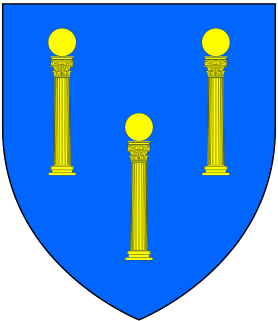
Sir John Major, 1st Baronet was a British merchant, Member of Parliament and Sheriff of Sussex. Major was born at Bridlington in the East Riding of Yorkshire, and started in business there, commanding a ship in the Stockholm trade. He apparently abandoned the sea at the age of around 30, but subsequently developed a thriving iron trade becoming eventually the largest dealer in the country. He built up a considerable fortune, acquiring extensive estates in Suffolk and Sussex and other land elsewhere in England, to a value of around £5,000 a year. Nevertheless, he put his shipping interests at the service of the nation when necessary, apparently at considerable cost to himself, providing ships to transport troops in time of war on more than one occasion.
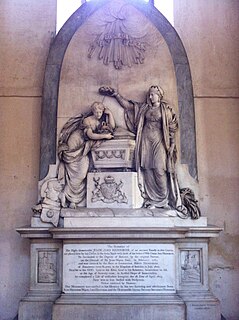
John Henniker, 1st Baron Henniker, known previously as John Henniker then as Sir John Henniker, 2nd Baronet, from 1782 to 1800, was a British merchant and Member of Parliament.
John Henniker-Major, 4th Baron Henniker, also 1st Baron Hartismere in the Peerage of the United Kingdom, was a British peer and Member of Parliament. He was educated at Eton College and St John's College, Cambridge.
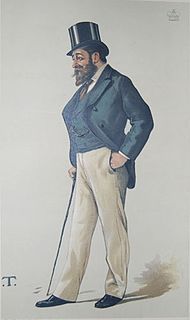
John Major Henniker-Major, 5th Baron Henniker VD DL, was a British peer and Conservative politician.
The Henniker Baronetcy, of Newton Hall in the County of Essex, was created in the Baronetage of the United Kingdom on 2 November 1813 for Brydges Henniker, who had earlier represented Kildare Borough in the last Irish Parliament. He was the youngest son of John Henniker, 1st Baron Henniker. The sixth baronet was an admiral in the Royal Navy and sat as Conservative member of parliament for Galloway. The eighth Baronet was a brigadier in the Royal Engineers. As of 2014 the present Baronet has not successfully proven his succession and is therefore not on the Official Roll of the Baronetage, with the baronetcy considered dormant since 2000.

Charles Henry Chandos Henniker-Major, 6th Baron Henniker, 3rd Baron Hartismere, DL was a British peer and British army officer.




















